Trading through earnings announcements usually isn’t a good idea. During earnings, most stocks tend to either increase or decrease significantly in value. Predicting the correct direction isn’t more than a 50/50 bet. That’s why I can’t recommend trading stocks through earnings announcements. With options, however, you have many more possibilities. Options allow you to profit from an entirely different angle. I will present a way that will allow you to profit from trading options on earnings.
To fully understand everything discussed in the following article, you should already be familiar with basic option concepts (including the Greeks). If you aren’t, I highly recommend checking out my Free Options Trading Education.
What are Earnings Announcements
But first of all, what are earnings announcements? Earnings announcements are the events where companies publicly announce their earnings or in other words their net income (after-tax). This event can be very important for stocks because it reflects the health of a company and its performance. That’s also why stocks tend to make big moves on earnings.
The actual earnings number of a company isn’t almost the most important aspect of an earnings announcement. Before earnings analysts and other people form predictions. These predictions can often be very important. If the real number beats the expectations, it is a bullish sign and if the real number doesn’t beat the expected outcome, it usually is a bearish sign.
Trading Options on Earnings – The Theory
The idea behind the option strategy that I am going to present to you in just a moment focuses on implied volatility (IV). Implied volatility is the expected volatility over the next X amount of days. It is much easier to predict changes in implied volatility than it is to predict changes in the actual stock price.
During the time period leading up to the earnings announcement, implied volatility normally rises to very high levels. In other words, people expect the underlying asset to move a lot. Directly after the earnings are reported, implied volatility tends to drop significantly. The reason for this is that the news already is out and thus, there is no reason to expect further increased volatility.
With options, it is possible to profit from this very predictable drop in implied volatility.
How to Profit from the IV Crush
There are relatively many option trading strategies that allow you to profit from a drop in implied volatility. Straddles, Strangles, Iron Condors, Short Calls/Puts, Butterflies… just to name a few. However, there are only a few option strategies that are good choices for this purpose.
As we don’t want to bet on the direction of the underlying’s price, neutral strategies are the number one choice. But obviously, you could theoretically also choose a directional strategy if you have a certain direction that you think the underlying asset will move in. But note that this probably just will be a 50/50 bet.
Viable neutral strategies that profit from decreasing implied volatility are:
- Short Straddles
- Short Strangles
- Short Iron Condors
Short Straddles
Short Straddles consist of two short ATM options at the same strike price. They collect the most premium meaning that they have the largest max profit of all the above strategies. On the other hand, the probability of profit of short straddles is the lowest of these three strategies. The breakeven-points of short straddles usually are closer to the underlying’s price than the breakeven-points of short strangles and iron condors.
The following image shows the payoff diagram and some other features of a short straddle:
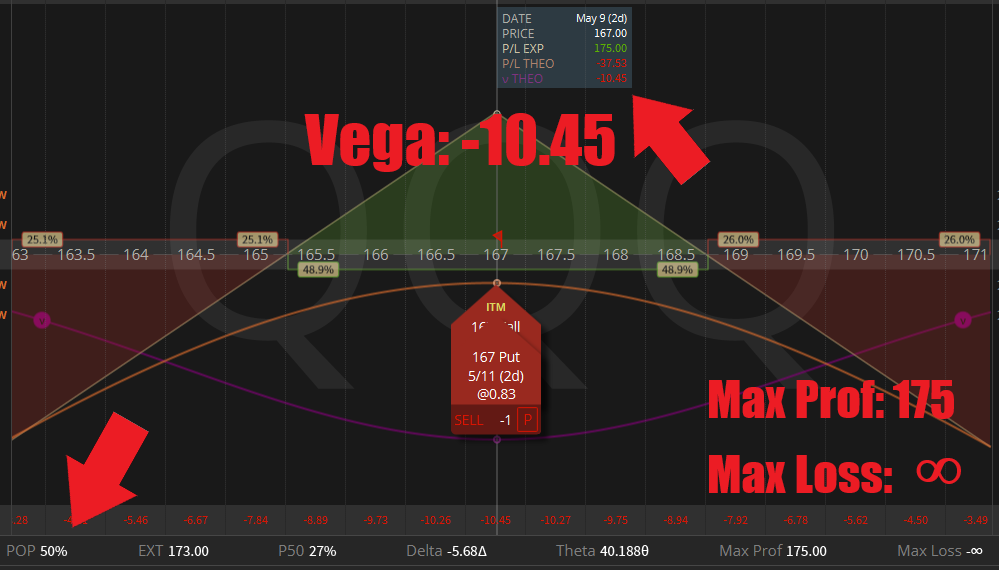
As you can see, short straddles are a defined profit and undefined risk strategy. This is due to the two naked (short) options. The Vega of this specific straddle is -10.45 meaning that this straddle would lose almost $10.5 for a 1% increase in implied volatility. On the other hand, this straddle would gain almost $10.5 for a 1% drop in IV.
After an earnings announcement, implied volatility often drops by a lot. Therefore, strategies with a big negative Vega profit the most.
The Straddle above has a probability of profit (POP) of about 50% and a max profit of $175.
Short Strangles
Short Strangles are another undefined risk and defined profit strategy. They consist of one OTM short put and one OTM short call.
Here is an image of the payoff diagram of a short strangle:
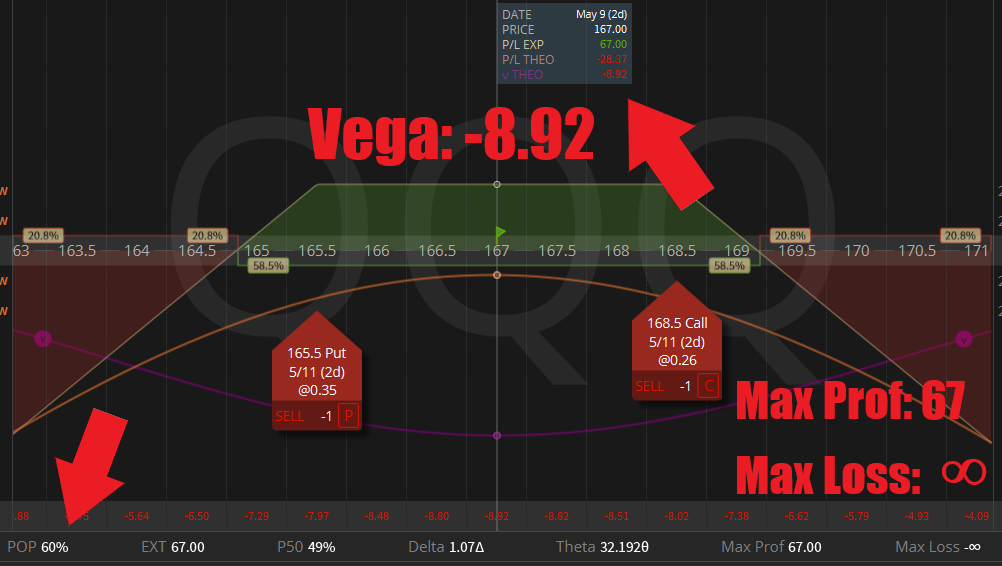
The Vega for this strangle is -8.92 which is only slightly less negative than the Vega of the previous short straddle. Thus this strangle would still gain almost $9 for a 1% drop in IV. But the max profit for this strangle is only $67 which is considerably lower than that of the straddle.
However, the probability of profit (POP) for this strangle is 60% compared to only 50% (the POP of the straddle). The probability of profit is higher because the strikes are further out. This leads to a bigger range in which the underlying asset’s price can move in.
Iron Condors
Iron Condors are a defined profit and defined risk strategy meaning that your risk (and profit) is limited. Once again, the following image shows the payoff diagram of an iron condor. An iron condor basically is a strangle with two long options added to each side to define the risk.
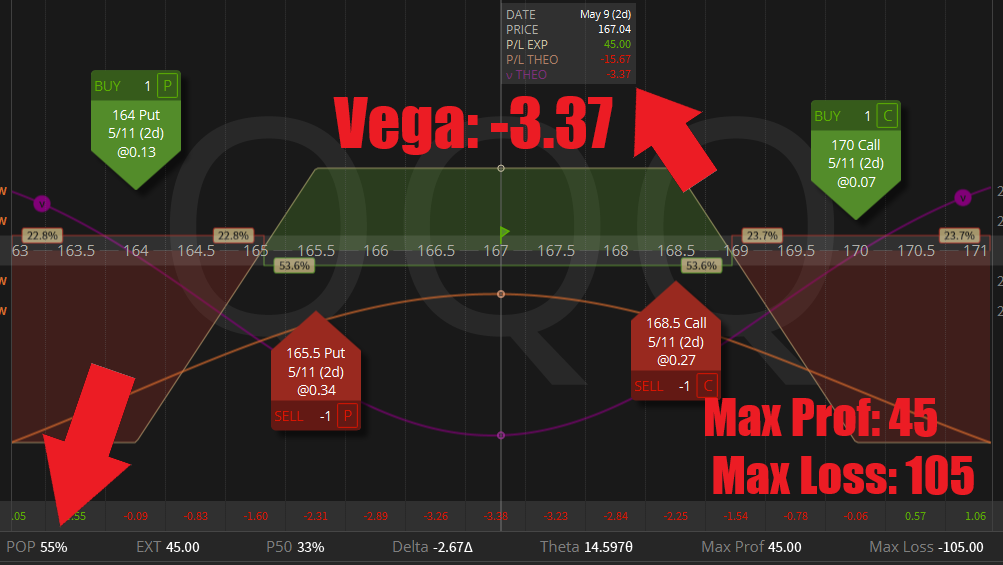
For this iron condor, the Vega is only -3.37. Therefore, this (and most other iron condors) profit much less from decreasing implied volatility than straddles and strangles. Furthermore, the max profit is only $45 which again is less than that of the other two strategies. The max loss, however, is not unlimited. It is capped at $105. The probability of profit of this iron condor is 55%.
As you can see, the three discussed strategies vary in different aspects: some profit more from decreasing volatility than others. Others, on the other hand, have a better probability of profit and so on. To compare these strategies, I created the following table. Each row compares a different aspect of these strategies. I marked the ‘winners’ of each aspect with green and the ‘loser(s)’ with red.
 (Click HERE to download the table above)
(Click HERE to download the table above)
In my opinion, there is no clear winner here. Not one strategy is superior in every aspect. I think the strategy choice really depends on personal preferences like account size, risk tolerance…
All of the previous example strategies were on the same underlying asset. But note that implied volatility wasn’t very high at the time of creating this article. Therefore, the credit collected (max profit) wasn’t very high. In times of high IV, you should be able to collect much more. Thus, the stats will be better in times of high IV. In addition to that, you could have chosen different strike prices/expiration dates… This would again impact all of the above stats.
The three mentioned strategies are excellent choices for this strategy. However, this does not mean that they are the only possible choices. If you want to add a directional component to this trading style, you may very well do so. Just make sure that the strategy you choose has all of the following aspects:
- Negative Vega: As this strategy revolves around profiting from decreasing implied volatility, you want a negative Vega. The more negative, the better.
- ‘High’ POP: Stocks often move a lot around earnings. To protect yourself against big moves, you should try to give the stock’s price some room to move in. So try to have a relatively high probability of profit on your strategy.
- Positive Theta: Ideally, your strategy should also have a positive Theta. Having this will allow your strategy to profit from time passing by.
How to Choose An Expiration Date:
Options with different expiration dates have different implied volatilities. The following image shows the implied volatility of different expiration cycles.
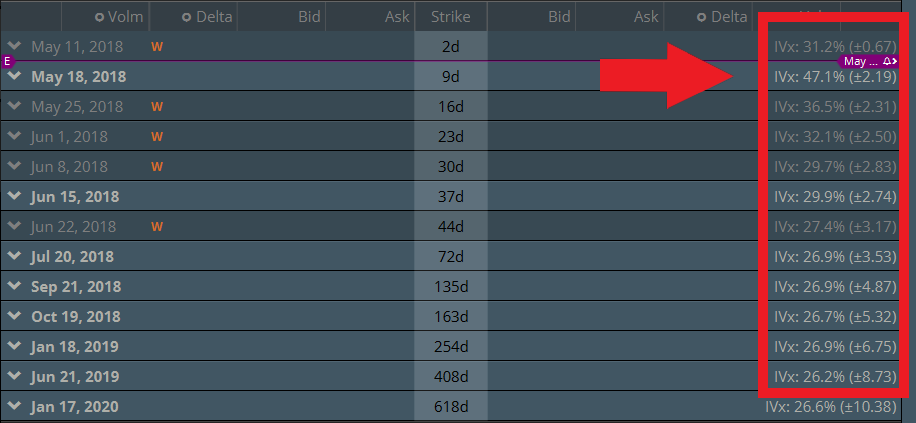
The purple line indicates the earnings date of this stock. As you can see the expiration cycle directly after earnings, has the highest IV. This is because an unusual big move is expected during the earnings release. Over time, the move in the stock’s price normalizes itself and doesn’t become extreme, thus the IV of the other expiration cycles is lower. The IV of other expiration cycles can give you a great idea of how far IV can/will drop. For example, on the image above, the IV of the May 18 expiration cycle (closest to earnings announcement) was at 47.1% at the time of writing this. The IV of the Jun 15 cycle was only 29.9%. Therefore, a 17.4% drop in IV can be expected, but obviously, there is no guarantee that this will happen.
As the expiration cycle that is closest to the earnings release, usually has the highest IV, it often is the best choice. The goal is to profit from an IV drop and it is this expiration cycle that normally has the biggest drop in IV. But if you prefer giving the underlying stock more time, you could also choose a later expiration date. Just make sure that IV still is high enough.
How To Choose Strike Prices:
When choosing strike prices, you should consider the expected move which can be calculated with options prices. Broker platforms like Tastyworks display the expected move directly on the option chain. This is a very useful feature. The following screenshot shows this feature:
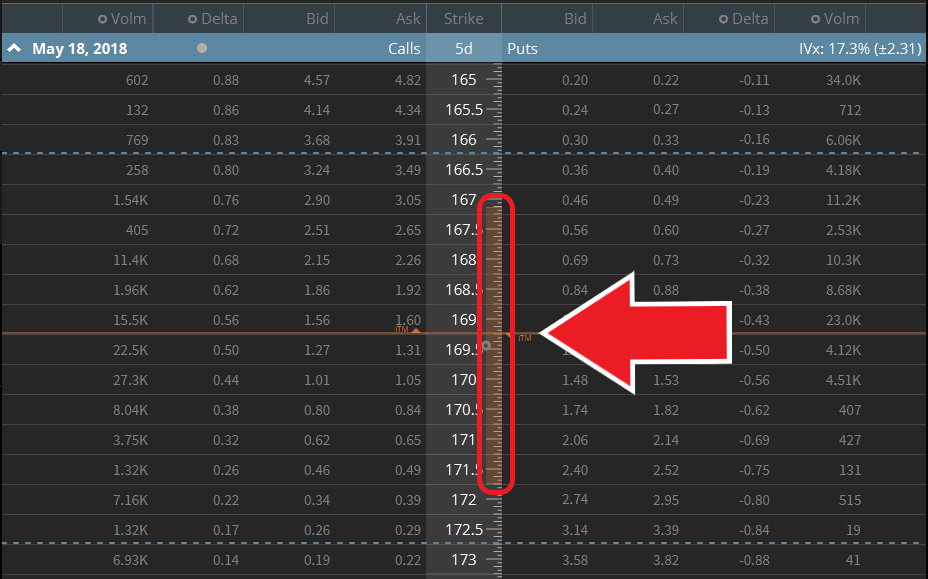
Ideally, your strategy should cover this expected move. But once again, this depends on your personal preferences. If you want to be extra conservative, you can go much further out to cover the expected moves multiple times. If you’re extra aggressive, you could do the exact opposite. But note, the further out you go, the higher your POP becomes. With a rising POP, your max profit decreases when going further OTM.
If you have a directional assumption, you could also just cover the move on one side.
Other Tips:
- Usually, IV rises up until the earnings release. Therefore, we want to wait as long as possible before entering an earnings play position. A good time to enter is shortly before the market close or at least as close as possible to the market close. This will not only let IV rise most, but it will also decrease the directional risk. If you enter the position too early, the stock’s price could already move a lot. Remember the goal is to profit from IV and not from movement in the stock’s price.
- Only trade a stock on earnings if it has high enough IV. To find out if it has high IV, you should use IV Rank. IV Rank compares the current IV on an asset to historical IV of the same asset and displays a number between 0 and 100. The higher IV Rank is, the higher the current IV of an asset is relative to previous times. I wouldn’t recommend picking stocks with IV Rank under 50 for this strategy.
- Focus on the big name, liquid stocks! Don’t try this strategy on every optionable stock that reports earnings. Only the ones with enough liquidity are relevant. So make sure that the volume/open interest of both the options and stock are high enough.
- Look at the stock price movement of the stock during past earnings announcements. If an asset always has made huge moves after an earnings release, chances aren’t low that it will do the same again. In this strategy, we profit from a less than expected move. Therefore, you could look at past events to get an idea of what might happen. If you can, you could also look at what happened to IV during the previous earnings announcements.
- Always stay small! This strategy does definitely not have a 100% win rate. Therefore, you should never risk too much on one trade. Never risk more than you are actually willing to lose. Often stocks move a lot at earnings, so make sure to manage your risk.
- Don’t aim for max profit. In this strategy, we are profiting from a drop in IV. A big enough drop in IV can lead to a good profit in your position. However, it will rarely lead to max profit. Thus, a good profit target is 50%. To diminish the directional risk, even more, you could also take off the position directly after the market open after the earnings release.
Examples:
Here are some examples of the implied volatility crush directly after earnings announcements. The red line represents the earnings dates of the stocks. The following charts are implied volatility charts.
The first example is the IV crush of Disney (DIS). As you can see, implied volatility dropped significantly as soon as the earnings were announced.

The next example is Chipotle (CMG). Once again, implied volatility dropped a lot shortly after the earnings release. The IV dropped by more than 10 points.

The following chart displays the implied volatility of Apple (AAPL). The same scenario as on the previous can be recognized.

The last example of this article is Amazon (AMZN). On Amazon, implied volatility was already down-trending from a previous event. Nevertheless, the IV rose a little up to the earnings release. Directly after it, IV dropped substantially.

All of the above charts are taken from marketchameleon.com
Conclusion
Up until earnings announcements implied volatility tends to increase. As soon as the news is out, implied volatility usually drops substantially.
Trading options on earnings and trying to profit from this drop in IV during earnings is a good strategy. However, it is everything else than guaranteed. Often stocks move a lot around earnings. Therefore, it is important to keep position sizes small and to know what you are doing.
Remember that this strategy tries to profit from IV and it is not a directional strategy.
Most Of The Above Screenshots Are Screenshots From My Favorite Broker Platform, TastyWorks. Check Out My TastyWorks Review!


This post takes trading options a lot deeper than I had expected!
How does removing the position directly after the market open after earnings release diminish directional risk? That part confused me.
I’m going to have to go back and read this a few more times before putting it into action. I’m excited to try it out (and keep it small).
Based on the graphics you provided, I’m assuming that TestWorks supports the different strategies you’ve outlined here?
Thanks for the comment. Yes, TastyWorks supports all these strategies. Iron condors can be traded in all account types. Strangles and Straddles, however, can only be traded in margin accounts with enough capital.
Opening the position directly before the market close and closing it directly after the market open the next day will decrease the time in the trade as much as possible. Therefore, the underlying stock will only have little time to move. Thus, you decrease the directional risk. Nevertheless, the directional risk does still exist as the stock can move pre-market and after-hours.
The longer you are in a position, the more you will be exposed to the directional risk.
Great post, Louis. The strategies are clearly defined and explained.
I have not traded options around earnings before, so I appreciate knowing that a couple of the strategies you mentioned have unlimited potential loss. That said, if I was interested in trading a short straddle or a short strangle around earnings, is there anything I could do to protect myself from potentially losing a large amount of money on such a trade?
I am also curious as to how you can properly time your exit strategy. If profiting from volatility, I would think the trade would start to lose value as volatility decreases after the earnings announcement. Thanks for another great post.
Hey Laura. Thanks for the comment.
I recommend to always set a max risk level on every trade. A good max risk level for strangles is three times the credit collected. So if you collect $200, a max risk level could be $600. You could send out a stop-loss order at this risk level when entering the trade. However, if the underlying asset’s price moves a lot pre-market or after hours, you might not be able to exit your position during that time.
If you truly want to limit your risk, you have to do so when opening a position by buying options as protection (so by turning a strangle into an iron condor). If you want to enjoy some of the benefits of strangles and at the same time have a defined risk, you could consider trading a very wide iron condors. However, this will lead to a relatively large max risk.
Short option strategies like short iron condors, straddles and strangles profit from decreasing implied volatility. So they gain value if IV drops after earnings. Generally, it can be a good idea to exit earnings plays directly after the market open after the earnings announcement.